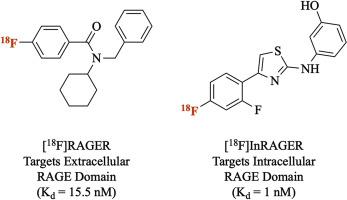Journal of Pharmaceutical Analysis ( IF 8.8 ) Pub Date : 2020-08-04 , DOI: 10.1016/j.jpha.2020.07.009 Lindsey R. Drake , Allen F. Brooks , Jenelle Stauff , Phillip S. Sherman , Janna Arteaga , Robert A. Koeppe , Aimee Reed , Timothy J. Montavon , Marc B. Skaddan , Peter J.H. Scott

|
The implication of the receptor for advanced glycation end-products (RAGE) in numerous diseases and neurodegenerative disorders makes it interesting both as a therapeutic target and as an inflammatory biomarker. In the context of investigating RAGE as a biomarker, there is interest in developing radiotracers that will enable quantification of RAGE using positron emission tomography (PET) imaging. We have synthesized potential small molecule radiotracers for both the intracellular ([18F]InRAGER) and extracellular ([18F]RAGER) domains of RAGE. Herein we report preclinical evaluation of both using in vitro (lead panel screens) and in vivo (rodent and nonhuman primate PET imaging) methods. Both radiotracers have high affinity for RAGE and show good brain uptake, but suffer from off-target binding. The source of the off-target PET signal is not attributable to binding to melatonin receptors, but remains unexplained. We have also investigated use of lipopolysaccharide (LPS)-treated mice as a possible animal model with upregulated RAGE for evaluation of new imaging agents. Immunoreactivity of the mouse brain sections revealed increases in RAGE in the male cohorts, but no difference in the female groups. However, it proves challenging to quantify the changes in RAGE due to off-target binding of the radiotracers. Nevertheless, they are appropriate lead scaffolds for future development of 2nd generation RAGE PET radiotracers because of their high affinity for the receptor and good CNS penetration.
中文翻译:

对高级糖基化终产物(RAGE)的受体进行PET成像的策略
在许多疾病和神经退行性疾病中,晚期糖基化终产物(RAGE)受体的含义使得它既作为治疗靶标又作为炎症生物标记物而引起人们的兴趣。在研究RAGE作为生物标志物的背景下,人们感兴趣的是开发放射性示踪剂,该示踪剂将能够使用正电子发射断层扫描(PET)成像对RAGE进行定量。我们已经为细胞内([ 18 F] InRAGER)和细胞外([ 18F] RAGER)的RAGE域。在此,我们报告了使用体外(铅板筛查)和体内(啮齿动物和非人类灵长类动物PET成像)方法的临床前评估。两种放射性示踪剂均对RAGE具有高亲和力,并显示出良好的大脑吸收能力,但存在脱靶结合的问题。脱靶PET信号的来源并非归因于与褪黑激素受体的结合,但仍无法解释。我们还研究了脂多糖(LPS)处理的小鼠作为可能的动物模型的使用,该动物模型的RAGE上调用于评估新的成像剂。小鼠大脑切片的免疫反应性显示,男性队列中RAGE升高,而女性群体中无差异。然而,事实证明,量化由于放射性示踪剂脱靶结合而引起的RAGE变化具有挑战性。不过,


























 京公网安备 11010802027423号
京公网安备 11010802027423号